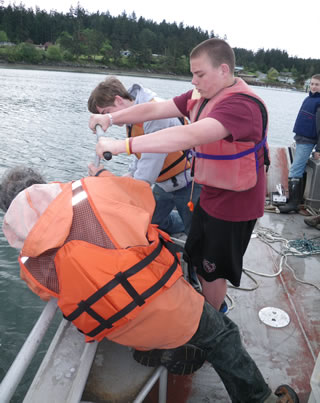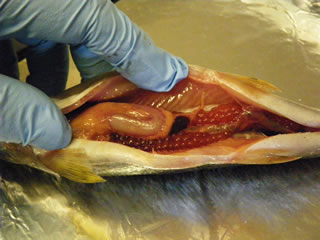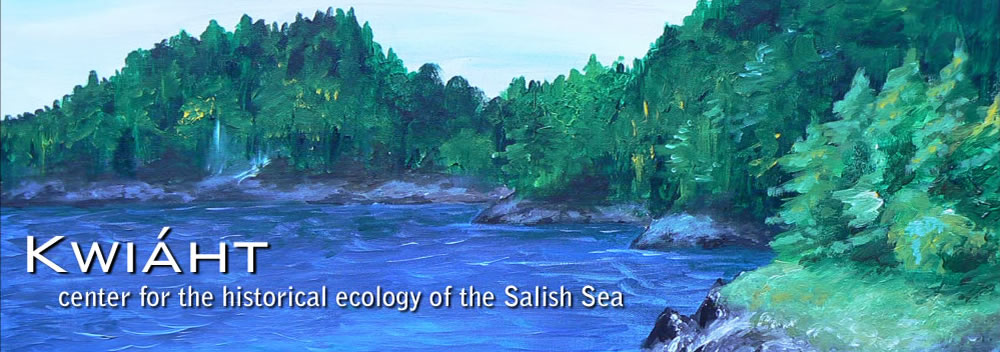Habitat Quality, Safe Food and Water
Determining baseline levels and monitoring changes in the concentration of local-source contaminants in the islands' ecosystems is complementary to our efforts to identify low-toxicity alternatives for the islands' consumers. Water quality measures are problematic because the concentrations of contaminants vary seasonally, with rainfall and changes in human activities, and can even vary from hour to hour in an urban storm drain system or receiving waters, if it has a wide variety of inputs from homes and businesses. We have concluded that accumulations of toxics in sediments, in animals (especially species that humans harvest for food), and on artificial substrates we have designed as collectors, on time scales of weeks to months, are more accurate and meaningful to our community.

Coring sediments in Fisherman Bay
Kwiáht's students conducted a baseline study of pyrethroid pesticide and PCB loads in clams from four beaches in East Sound (Orcas Island), closer and farther from the town of Eastsound and its storm sewer outfall, in 2010. Results demonstrated that local source pollution, while relatively small in comparison with toxic inputs from nearby cities such as Seattle and Vancouver, was nevertheless sufficient to render clams from some island beaches unsafe to eat. East Sound clams will continue to be tested periodically.
Kwiáht student projects have also determined baseline loads of pesticides, surfactants, PAHs and heavy metals in many of the islands' ponds and streams, including fish in the False Bay watershed, the archipelago's largest. Local students also compared sediment loads of copper and heavy hydrocarbons in the islands' three most developed bays, and extensively mapped the distribution of copper in Fisherman Bay sediments and wetlands surrounding the bay as an exercise in identifying likely sources.

Dissecting trout for heavy metals analysis
Methods development is an important part of Kwiáht's program of investigating toxics with students. Our associate Jack Bell and students refined the standard MBAS method for determining LAS-type surfactants in a way that uses inexpensive, less toxic reagents and increases precision; and with interns Eliana Blaine and Steffan Iverson, developed an LC-MS method for determining the endocrine disrupting compounds Nonyl Phenol and DEHP in water. Kwiáht has also refined the use of polypropylene fabric as a collector of floating oils for rapid, reliable turbidimetric determinations of weekly or monthly loads in storm sewers and receiving waters.

Seawater intrusion study, Laura Strom
Seawater intrusion into aquifers is as much a concern for human health as contaminants, in the islands. Kwiáht intern Laura Strom conducted an extensive survey of Lopez wells for evidence of seawater intrusion in 2010, a little more than a decade after a USGS study raised concerns about the island's potable water supply.
Research Papers (referenced above):
